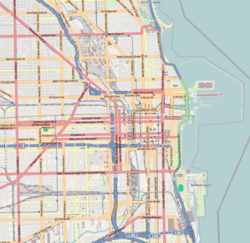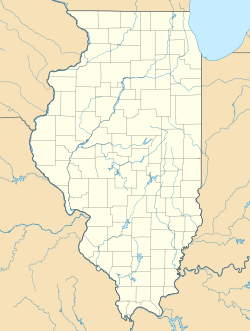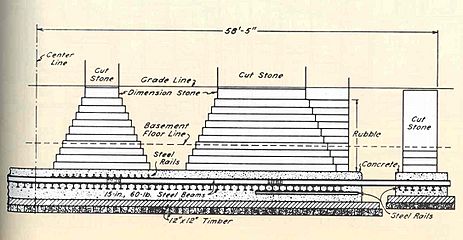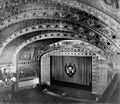Auditorium Building facts for kids
|
Auditorium Building
|
|
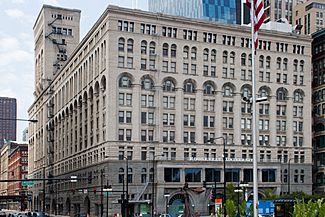
Building's exterior in 2012
|
|
| Location | 430 S. Michigan Ave. Chicago, Illinois |
|---|---|
| Area | 67,699.5 square feet (6,289.49 m2) |
| Built | 1889 |
| Architect | Louis Sullivan Dankmar Adler |
| Architectural style | Late-19th- and early-20th-century American movements |
| Part of | Historic Michigan Boulevard District |
| NRHP reference No. | 70000230 |
Quick facts for kids Significant dates |
|
| Added to NRHP | April 17, 1970 |
| Designated NHL | May 15, 1975 |
The Auditorium Building is a famous building in Chicago, Illinois. It stands at the corner of South Michigan Avenue and Ida B. Wells Drive. It was finished in 1889. It is one of the most famous buildings designed by Louis Sullivan and Dankmar Adler. The building was made to hold many things: offices, a theater, and a hotel. A young architect named Frank Lloyd Wright helped design the inside.
The Auditorium Theatre is part of the Auditorium Building. It is located at 50 East Ida B. Wells Drive. This theater was the first home for the Chicago Civic Opera and the Chicago Symphony Orchestra.
The building was added to the National Register of Historic Places on April 17, 1970. It was named a National Historic Landmark in 1975. It also became a Chicago Landmark on September 15, 1976. Since 1947, the Auditorium Building has been part of Roosevelt University.
Contents
Why the Auditorium Building Was Built
Ferdinand Peck, a Chicago businessman, started the Chicago Auditorium Association in 1886. He wanted to build the biggest and most amazing theater in the world. He hoped it would be as grand as the Metropolitan Opera House in New York City. Peck wanted to make high-quality art and music available to everyone in Chicago.
The building was also planned to have offices and a fancy hotel. Peck convinced many important Chicago business leaders to join him. These included Marshall Field, Edson Keith, Martin A. Ryerson, Charles L. Hutchinson, and George Pullman. The group hired the famous architects Dankmar Adler and Louis Sullivan to design the building. At that time, Frank Lloyd Wright worked for their firm. He might have helped with some of the designs.
The Auditorium Building was built for a group of business people. They wanted a large opera house for the city. To help pay for it, they decided to add a hotel and office spaces around the theater. This meant Adler & Sullivan had to design a building with many different uses. The hotel faced Michigan Avenue, looking out over the lake. The offices were on the west side, facing Wabash Avenue. The main entrance to the theater is on the south side, under the tall, 18-story tower. The rest of the building is ten stories tall. The beautiful decorations inside were all designed by Sullivan. Some of these designs have flowing, natural shapes.
How the Building Was Designed
Sullivan and Adler created a very tall building. Its outer walls were designed to hold up the entire structure. The outside look was partly inspired by H.H. Richardson's Marshall Field Warehouse. The Auditorium Building looks very strong and impressive from the outside. When it was finished, it was the tallest building in Chicago. It was also the largest building in the United States.
One very clever part of the building was its huge "raft foundation." Adler and engineer Paul Mueller designed this together. The ground under the Auditorium is soft blue clay that goes down more than 100 feet. This made regular foundations impossible. So, Adler and Mueller designed a floating mat. It was made of crisscrossed railroad ties. On top of that were two layers of steel rails set in concrete. The whole thing was covered with pitch.
This special foundation spread the building's huge weight over a large area. However, the heavy outer walls and lighter inside parts caused the foundation to settle over time. Today, some parts of the building have sunk by as much as 29 inches. You can clearly see this in the theater lobby. The mosaic floor there slopes noticeably as it gets closer to the outer walls. This settling happened because the design was changed during construction. The original plan was to cover the outside with lightweight terra-cotta. But this was changed to heavy stone after the foundations were already being built. Most of the settling happened within ten years after it was built.
In the middle of the building was a large auditorium with 4,300 seats. It was first meant for Grand Opera shows. To match Peck's idea of making art available to everyone, the theater was designed so all seats had good views and sound. The first plans did not even include box seats. When they were added, they were not given the best spots.
Around the central theater space, there were 136 offices and a 400-room hotel added in 1890. These were meant to bring in money to help support the opera. Even though the Auditorium Building was not just a business building, Peck wanted it to pay for itself. The money from the offices and hotel was supposed to keep ticket prices low. But in reality, both the hotel and offices stopped making a profit within a few years.
Later Uses of the Building
On October 5, 1887, President Grover Cleveland helped lay the first stone for the Auditorium Building. The 1888 Republican National Convention was held in the building even though it was not fully finished. At this event, Benjamin Harrison was chosen as a presidential candidate. On December 9, 1889, President Benjamin Harrison officially opened the building. The famous opera singer Adelina Patti sang "Home Sweet Home" to a huge cheer. Adler & Sullivan also had their offices on the 16th and 17th floors of the Auditorium tower.
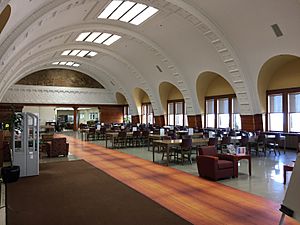
The Chicago Symphony Orchestra played its first concert on October 16, 1891. It stayed at the Auditorium Theatre until it moved to Orchestra Hall in 1904.
The opera company that used the theater moved to the Civic Opera House in 1929. The Auditorium Theatre then closed during the Great Depression. In 1941, the city of Chicago took it over. It was used as a center for soldiers during World War II. By 1946, Roosevelt University moved into the Auditorium Building. However, the theater itself was not fixed up to its original beauty.
In 1952, Congress Parkway was made wider. This brought the street curb right up to the south side of the building. To make space for a sidewalk, some rooms on the ground floor and part of the theater lobby were removed. A covered walkway was created instead.
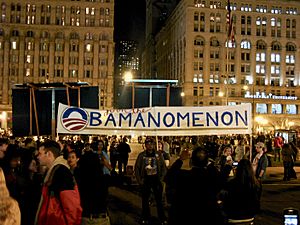
On October 31, 1967, the Auditorium Theatre reopened. From then until 1975, it was a popular place for rock concerts. Famous bands like the Grateful Dead played there ten times between 1971 and 1977. The Doors also played their first concert at the Auditorium Building after their singer Jim Morrison was arrested on June 14, 1969.
The U.S. Department of the Interior declared it a National Historic Landmark in 1975.
The building had the first central air conditioning system. The theater was also the first to be completely lit by incandescent light bulbs. In 2001, a big project began to restore the Auditorium Theatre. The goal was to bring back its original colors and finishes.
On April 30, 2015, the National Football League held its 2015 NFL draft in the Auditorium Theatre. It was the first time the NFL had held its yearly draft in Chicago in over 50 years.
Images for kids
See also
 In Spanish: Auditorium Building para niños
In Spanish: Auditorium Building para niños


